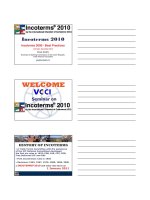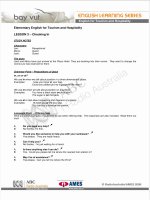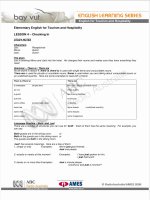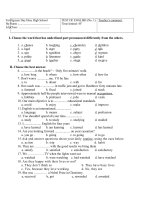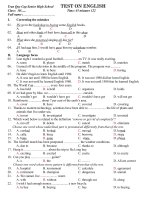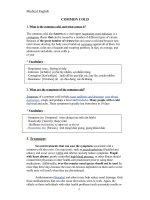act aspire english exemplar 2
Bạn đang xem bản rút gọn của tài liệu. Xem và tải ngay bản đầy đủ của tài liệu tại đây (64.59 KB, 11 trang )
Exemplar Test Items
English
2
© 2013 by ACT, Inc. All rights reserved.
NOTE: This booklet is covered by Federal copyright laws that prohibit the
reproduction of the test questions without the express, written permission of ACT, Inc. 20588
3
ACT Aspire
T
M
English
Introduction
ACT Aspire English Tests assess students’ developed ability to revise and edit texts. A typical English Test
contains several stimuli, or texts, and a series of items, or questions.
Texts used in the assessments represent various content areas (including English language arts, the humanities,
and the social and natural sciences), and, considered collectively, reflect a range of text complexity levels from
simple to complex, as appropriate for students’ age and educational attainment.
Conventions of Standard English
The questions in this cluster require students to apply an understanding of the conventions of standard
English grammar, usage, and mechanics to revise and edit text.
Punctuation Conventions.
These questions require test takers to edit text to conform to standard English punctuation.
Usage Conventions.
These questions require test takers to edit text to conform to standard English usage.
Sentence Structure and Formation.
Questions in this category test understanding of relationships between and among clauses, placement
of modifiers, and shifts in construction.
Production of Writing
The questions in this cluster require test takers to apply an understanding of the rhetorical purpose and
the focus of a piece of writing to develop a topic effectively; to use various strategies to achieve logical
organization, topical unity, and general cohesion; and to employ knowledge of language to ensure that writing
is precise, concise, and stylistically consistent.
Topic Development.
These questions require test takers to demonstrate an understanding of and control over the rhetorical
aspects of texts by identifying the purpose of parts of texts, determining whether a text has met its intended
goal, and evaluating the relevance of material in terms of a text’s focus.
Organization, Unity, and Cohesion.
These questions require test takers to use various strategies to ensure that text is logically organized, flows
smoothly, and has an effective introduction and conclusion.
Knowledge of Language.
These questions require test takers to demonstrate effective language use through ensuring precision and
concision in word choice, maintaining consistency in style and tone, and using references.
4
* correct answer
ACT Aspire Early High School English
C
ycling About
[
1]
In 1817, Baron von Drais of Germany, tired of walking, tried to come up with an easier way to explore his
expansive gardens. He attached two equal-sized wooden wheels to a wooden plank and connected the
front wheel to a bar for steering. [A] The baron propelled the device by straddling the plank and running
his feet along the ground. While this
Laufmaschine (running machine), as von Drais called it, was
uncomfortable to ride and nearly impossible to steer. Even so, it inspired the public to imagine a new
two-wheeled means of transportation—and encouraged inventors to create just that.
[2]
By the 1860s, French craftsman Pierre Michaux, had designed a bicycle-like machine that featured a
lightweight iron frame and pedals. But it was not perfect. Called the vélocipède, or fast foot, it became
popularly called as the “boneshaker.” Its stiff, hardwood wheels made for a jarring ride on bumpy
cobblestone roads. Only the strongest men could navigate the boneshaker—and even they had to ride
slowly. [B]
[3]
Hoping to provide the public a faster, smoother ride, English manufacturers in the 1870s introduced the
“high-wheel” bicycle. It included a huge front wheel paired with a tiny back wheel, both with cushiony
rubber tires. [C] The problem, though, was that riders had to sit perched high up on these bicycles,
creating a hazard regarding their position when they rode. Most people—with the exception of daring
young men—didn’t ride the high-wheel.
[4]
Not until the 1890s, after attempts to make high-wheel bicycles safer had failed, were “safety” bicycles
introduced in Europe and the United States. These models varied significantly in price. American
suffragist Susan B. Anthony called the safety the “freedom machine.” [D] Finally, almost everyone could
move about with ease on a bicycle—and they did.
1
2
3
4
5
5
* correct answer
1. A. NO CHANGE
B
. Regardless of whether this
C. Considering that this
*D. This
2. A. NO CHANGE
B. craftsman, Pierre Michaux,
C. craftsman, Pierre Michaux
*D. craftsman Pierre Michaux
3. A. NO CHANGE
B. referred
*C. known
D. said
4. Which choice provides the most precise information about a potential effect of riders having to sit
high up on the high-wheel bicycle?
A. NO CHANGE
B. frightening situation in terms of their orientation.
*C. dangerous tipping hazard.
D. fearful issue.
5. Given that all the choices are accurate, which one provides the most relevant information at this
point in the essay?
A. NO CHANGE
*B. had two equal-sized wheels, inflatable rubber tires, reliable brakes, and frames that allowed men,
women, and children to ride comfortably.
C. led to the formation of groups and clubs such as the League of American Wheelmen (today called
the League of American Bicyclists).
D. were made and sold even though many roads were still unpaved and difficult to ride on.
6. The writer is considering adding the following sentence to the essay:
The incredibly large front wheel allowed riders to travel farther and faster with only one
rotation of the pedals.
If the writer were to add this sentence, it would most logically be placed at which of the
following points?
A. Point A in paragraph 1
B. Point B in paragraph 2
*C. Point C in paragraph 3
D. Point D in paragraph 4
6
* correct answer
ACT Aspire Grade 8 English
G
host Bird
I
n 1951, fifteen-year-old David Wingate examined the limestone cliffs of the Bermuda Islands. He was
looking for the Bermuda petrel, or cahow, a seabird once so common that the Bermuda night sky was
filled with its eerie cries. The bird, thought to have been extinct for three hundred years, had reportedly
been spotted—twice. Wingate, a bird lover and Bermuda native, had joined a team of naturalists who
were hoping to confirm the reports. For days they searched,
the team found a cahow chick tucked into a
crevice, along with a few other cahow nests.
Wingate became focused on saving the cahow. After leaving Bermuda to study zoology at Cornell
University in New York, he returned in the late 1950s to search the islands for the bird. He found
eighteen nesting pairs, most of them fairly healthy, on several remote islets. Though the cahow still
existed, Wingate knew that its current breeding habitat—burrows created in fragile limestone cliffs—
was threatened by hurricanes, rising sea levels, and erosion.
Over a period of years Wingate, as Bermuda’s, conservation officer, transformed an elevated,
uninhabited fifteen-acre Bermuda island that was unpopulated, called Nonsuch, into a haven for this
endangered species. He restored native flora and created dozens of sturdy, soil-filled burrows, providing
the cahow with safe nesting places. Speakers played prerecorded cahow calls to attract the first birds.
Soon, there were eight pairs of cahows nesting on Nonsuch Island.
Wingate feels, however, that there is no sound more beautiful than the haunting cries of the cahow—
the unbelievably reappearing “ghost bird,” as he calls it—again filling the Bermuda night sky. In 2009,
eighty-six nesting pairs on Nonsuch Island produced dozens of healthy chicks that left they’re burrows
to fly out to sea. Many of these birds returned to Nonsuch to make nests of their own.
7
8
9
10
11
12
7
* correct answer
7. A. NO CHANGE
B
. Days passed as they searched,
C. They spent days searching,
*D. After days of searching,
8. Given that all the choices are accurate, which one most clearly emphasizes how close the cahow
was to extinction when Wingate began his project?
A. NO CHANGE
B. some of the pairs having made sturdy nests in the cliffs,
*C. likely the cahow’s entire breeding population,
D. more cahows than he had expected to find,
9. A. NO CHANGE
*B. years, Wingate, as Bermuda’s conservation officer,
C. years, Wingate, as Bermuda’s conservation officer
D. years Wingate, as Bermuda’s conservation officer
10. A. NO CHANGE
B. area of Bermuda that was relatively high up,
C. place that was soon to be a haven,
*D. Bermuda island,
11. A. NO CHANGE
B. feels, therefore,
C. feels, likewise,
*D. feels
12. A. NO CHANGE
B. there
*C. their
D. it’s
8
* correct answer
ACT Aspire Grade 6 English
P
ie Through the Ages
T
oday, pies filled with sweet, fruity filling are a dessert favorite. But in the time of ancient Greece, people
only filled pies with meat, poultry, or seafood. For many centuries, the pie’s pastry shell served primarily
as a means for baking, the
tough dough functioned if a pot or casserole dish does today. The crust also
served as a helpful way to carry, store, and serve food. The heavy crust did not go to waste after its filling
was gone, however. It was then used to thicken stews.
Many children grow up hearing the nursery rhyme about blackbirds baked in a pie, but few
realize there is truth to the tale. In the 1500s, pies were often part of an evening’s entertainment.
Blackbirds would be sealed in an uncooked pie that would be presented to partygoers.
The birds which were quite ready to be freed, would fly around once the pie was cut open.
After arriving in North America, English colonists incorporated local ingredients into their pie recipes.
They used berries, dried fruit, eggs, and molasses. In the late 1700s, pies were made from apples that
were neither peeled nor cored. Some said the crust was so tough that it would not break, even if it were
run over by a wagon wheel.
[A] As America expanded westward in the 1800s, settlers hungry for pie had to learn to cope with what
tools were available, such as possum or vinegar. [B] As the United States grew, pie continued to be a
valuable part of American life. [C] A newspaper editorial in the early 1900s claimed, “Pie is the food of
the heroic. No pie-eating people can ever be permanently vanquished.” Pies have been a favorite food for
a long time, and today, apple pie is considered a symbol of American life. [D]
13
1
5
1
6
17
14
9
* correct answer
13. What change, if any, should be made to the underlined text?
A. NO CHANGE
*B. baking. The
C. baking the
D. baking the,
14. What change, if any, should be made to the underlined word?
A
. NO CHANGE
*B. like
C. after all
D. then
15. What change, if any, should be made to the underlined text?
A. NO CHANGE
B. birds which were quite ready to be freed
*C. birds, which were quite ready to be freed,
D. birds, which were quite ready to be freed
16. What change, if any, should be made to the underlined text?
*A. NO CHANGE
B. berries dried fruit eggs
C. berries dried fruit eggs,
D. berries dried fruit, eggs,
17. What change, if any, should be made to the underlined word?
A. NO CHANGE
B. features
*C. ingredients
D. portions
18. Where would be the best place to add the following sentence?
Pie was quite important to these settlers, and they ate it with almost every meal.
A. Point A
*B. Point B
C. Point C
D. Point D
10
* correct answer
ACT Aspire Grade 4 English
V
egetable Magic
T
he Vienna Vegetable Orchestra is creating a new, unusual sound with its music. This group performs
music by playing vegetables. The orchestras
strange instruments beep, whir, squeak, and thump.
Before each show, the orchestra members shop for fresh vegetables. Then, the musicians careful cut
and carve the food with knives. Sometimes they use a drill, too. As members work, a carrot becomes a
flute, and a pepper changes into a horn, a pumpkin is transformed into a fine bass drum.
The members of the orchestra loves the taste, smell, and look of their instruments. They also enjoy
sharing their special songs with others. The songs are influenced by many different styles, such as jazz,
electronic, and pop music.
After watching a Vienna Vegetable Orchestra performance. Audience members have another delight
waiting for them. The orchestra has a cook who makes a delicious soup from all of the vegetables. An
evening with the Vienna Vegetable Orchestra is a truly remarkable experience.
19
20
21
22
23
2
4
11
* correct answer
19. What change, if any, should be made to the underlined word?
A. NO CHANGE
*B. orchestra’s
C. orchestras’
D. orchestra
20. What change, if any, should be made to the underlined word?
A
. NO CHANGE
B. most careful
*C. carefully
D. more careful
21. What change, if any, should be made to the underlined text?
A. NO CHANGE
*B. horn. A
C. horn a
D. horn a,
22. What change, if any, should be made to the underlined word?
A. NO CHANGE
*B. love
C. has loved
D. loving
23. What change, if any, should be made to the underlined word?
*A. NO CHANGE
B. it’s
C. they’re
D. there
24. What change, if any, should be made to the underlined text?
A. NO CHANGE
B. performance audience
*C. performance, audience
D. performance audience,
